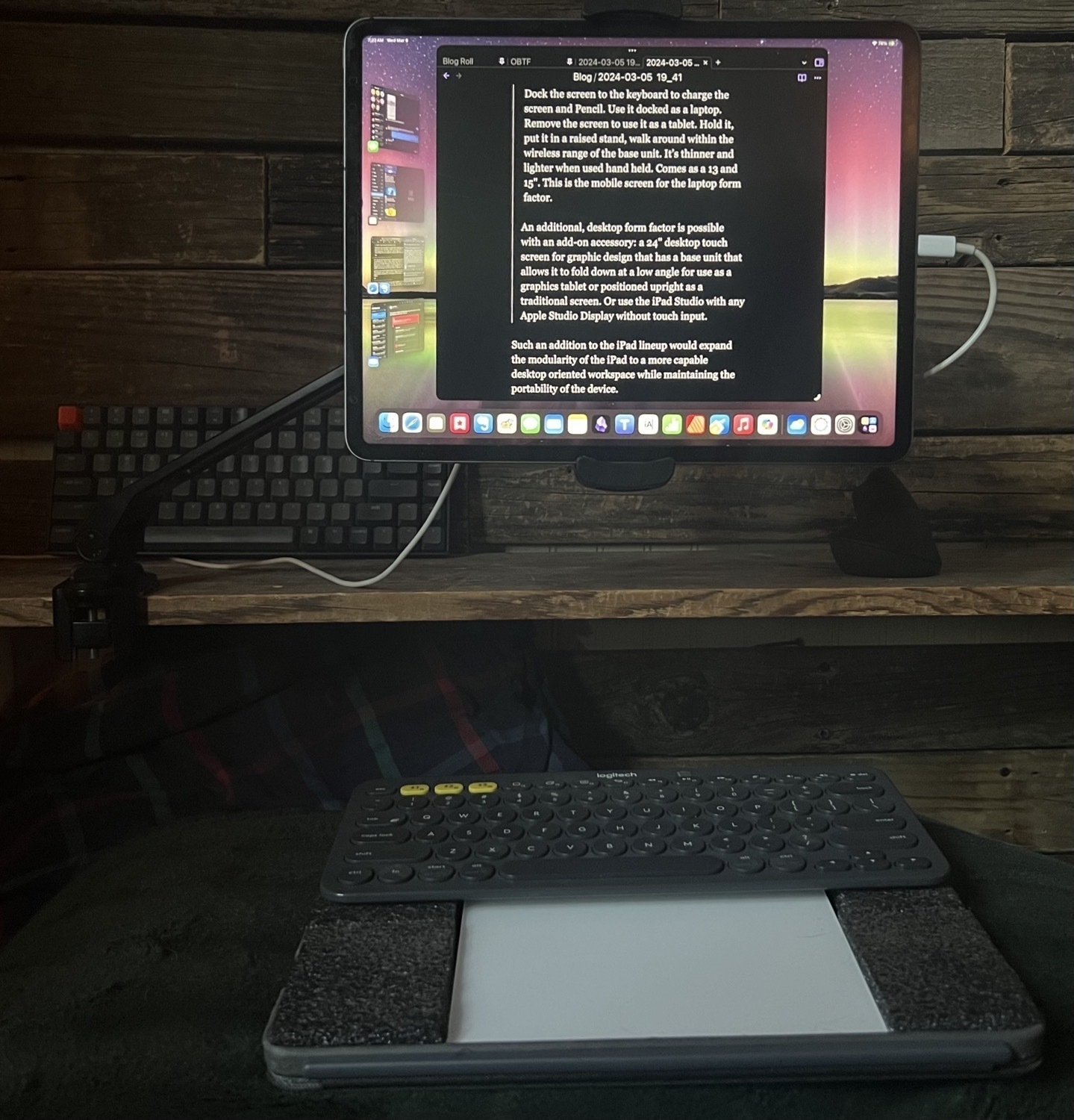The always evolving iPad set-up (and speculations on the iPad's future)
It's March of 2024 and we're expecting new iPad and likely a new Magic Keyboard sometime this month. Given Apple rolled out 2 new MacBook Airs on Monday I'd guess iPad releases will be next Monday, the 11th. My main interest isn't the iPad itself but the Magic Keyboard. I'm doubtful that it will be backward compatible put I'm not ruling it out. My hope is that it's backward compatible to 2018 models and that it's something closer to the Brydge keyboard offering. Heavier than the current Magic Keyboard for iPad, with a base that includes a battery and ports. Basically leaning into the laptop form factor.
 My latest configuration has the iPad in the Twelve South HoverBar Duo attached to a shelf near my futon or a shelf above my desk. And I think I've finally improvised my ideal around-the-house keyboard/trackpad platform. I repurposed a Logitech Combo-Touch. With a bit of black foam the trackpad is recessed and set in place. I can change between several Bluetooth keyboards as needed. It's lighter and more compact than my previous attempts using repurposed sheets of thin plywood.
My latest configuration has the iPad in the Twelve South HoverBar Duo attached to a shelf near my futon or a shelf above my desk. And I think I've finally improvised my ideal around-the-house keyboard/trackpad platform. I repurposed a Logitech Combo-Touch. With a bit of black foam the trackpad is recessed and set in place. I can change between several Bluetooth keyboards as needed. It's lighter and more compact than my previous attempts using repurposed sheets of thin plywood.
Which brings me to Federico Viticci's recent story about his new MacPad experiment. He was looking for a similar solution to create a unified keyboard deck for use with the VisionPro. He wasn't happy with the various options for sale so he removed the screen from his MacBook Air and added 3 hinged magnets to hold his iPad Pro which serves as the screen for accessing the Mac via Sidecar. The final solution lets him have access to the Mac, the iPad and the Vision Pro all from the Mac. Pretty neat for users that want a Mac-based, unified experience between the three platforms.
What he and many others really want is a combined touch screen computer that can run macOS and/or iPadOS. I don't think that's going to happen because Apple has another solution that it shipped with VisionOS:
For those that want macOS on an iPad, VisionOS has the solution. Build in native support for screen sharing with a Mac. If your preference is the Mac and the iPad is a secondary device then you’ll likely have a Mac nearby and the screen sharing that VisionOS offers would likely work just fine. I’ve got a Mac as a file server and when I need to check in on it to update the OS the Screens app is nearly perfect. I login and it feels as though I’m using macOS on the iPad.
I'd guess this will come with iPadOS 18 and will work on any M series iPad. Apple is expected to announce new iPad Pros this month along with an updated, more lap-top like Magic Keyboard which would go well with this solution. Unlike the Screens app a native Apple solution would take advantage of the full screen of an iPad when interfacing with the Mac. This solution fits well with the idea that Apple would rather users just have one of each device and it's likely true that many users already have both.
It's a bridge solution that allows for Apple to continue with a focus on each platform. I prefer iPadOS and the iPad, so I'd much rather see Apple spend time and resources on further development of the iPad. A few weeks ago I posted about Apple getting weird with the iPad line-up. I'm sure they'll continue with the iPad Pro but I can also imagine an iPad Studio similar to Federico's experiment in creating a screen-less Mac laptop. An iPad Studio would be housed in a keyboard, trackpad and battery base that would look nearly identical to a screen-less MacBook Air. The removable touch screen would be included and a much larger desktop touch screen would be optional:
The touch screen would be thinner and lighter than what we now know as an iPad. It would also have a battery just for the screen and the most minimal hardware to connect the two wirelessly. Dock the screen to the keyboard to charge the screen and Pencil. Use it docked as a laptop. Remove the screen to use it as a tablet. Hold it, put it in a raised stand, walk around within the wireless range of the base unit. It’s thinner and lighter when used hand held. Comes as a 13 and 15". This is the mobile screen for the laptop form factor.
An additional, desktop form factor is possible with an add-on accessory: a 24" desktop touch screen for graphic design that has a base unit that allows it to fold down at a low angle for use as a graphics tablet or positioned upright as a traditional screen. Or use the iPad Studio with any Apple Studio Display without touch input.
Such an addition to the iPad lineup would expand the modularity of the iPad to a more capable desktop oriented workspace while maintaining the portability of the device.